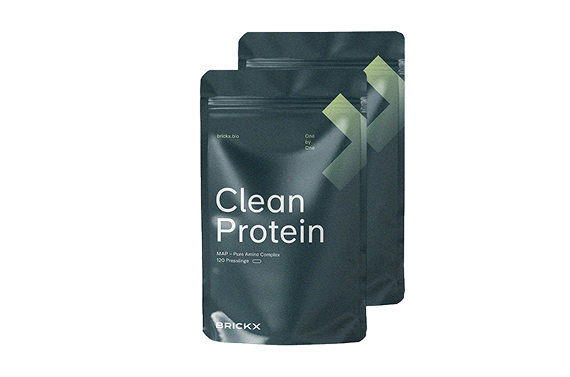Cell renewal from within - with essential amino acids

1. muscle mass is a lifetime - and it disappears early
From the age of 30, we lose around 1 % of our muscle mass every year - a process that accelerates with age and is medically referred to as 'muscle wasting'. Sarcopenia is called. This gradual change goes unnoticed for a long time, but affects key health factors: Metabolism, immune defense, mobility and hormone balance. Studies show that the loss of muscle mass is associated with an increased risk of frailty, falls, insulin resistance and even earlier death. Muscle mass is not just substance - it is reserve, regulation and resilience.
2. why essential amino acids are the key
Building and maintaining muscle mass is a highly precise biological process - and completely dependent on the supply of essential amino acids. Unlike non-essential amino acids, the body cannot produce these itself. They must be supplied through the diet. However, the ability to synthesize proteins efficiently decreases with age - a phenomenon known as anabolic resistance is known. This means that the body not only needs more protein, but above all precisely dosed, quickly available essential amino acids in order to effectively build or maintain muscle tissue.
Essentially available amino acids can be used in old age, among other things:
-
promote muscle protein synthesis and slow down muscle breakdown
-
reduce mitochondrial stress and improve cell energy
-
support glutathione levels - a cellular protective factor against oxidative stress
-
stabilize the production of hormones and enzymes
-
modulate the immune system and regulate inflammatory processes

3. protein metabolism and longevity
Longevity research is increasingly focusing on muscle health as a biometric marker for healthy ageing. Studies in gerontology show that muscle strength - not just mass - is a significant predictor of quality of life and life expectancy. Those who remain vigorous in old age not only have a lower risk of needing care, but also of cardiovascular disease, type 2 diabetes and cognitive degeneration. Essential amino acids are the molecular starting point: they not only control muscle synthesis, but also repair processes, immune responses and hormonal balance.
What you can do in everyday life to optimize care:
-
Distribute your protein intake evenly throughout the day - e.g. in 3 main meals, each containing 25-30 g of high-quality protein.
-
Combine animal and plant sources useful: e.g. egg & lentils, quark & oats, soy & whole grain - for a broader amino acid spectrum.
-
Increase bioavailability through targeted food combinations - e.g. fermented or sprouted legumes.
-
Include free amino acids specifically, especially in case of increased demand, low appetite or digestive problems.
-
Exercise regularly, especially strength-based exercise - Muscle training increases the signaling effect of amino acids on protein synthesis.
4 The context decides: Need, form, timing
Not only the quantity, but also the quality, availability and combination of the amino acids consumed is crucial. While many people believe that they are well supplied with amino acids through a “high-protein diet”, the actual Net availability often unclear. This is because whole proteins must first be digested, broken down and absorbed - a process that is often inefficient in old age. Highly available forms of essential amino acids - optimally adapted to human physiology - can help to compensate for deficiencies and cover protein requirements without digestive stress.
Conclusion
Muscle mass is not a question of vanity, but of life expectancy. With increasing age, a precise supply of essential amino acids becomes a prerequisite for healthy cell function, mobility and long-term vitality. Those who pay attention to the right form of protein early on are investing in their physical resilience - and thus in what is probably the most effective form of longevity.
-
Mitchell, W. K. et al. (2012): Sarcopenia, dynapenia and the impact of advancing age on human skeletal muscle size and strength. J Cachexia Sarcopenia Muscle.
-
Volpi, E. et al. (2013): Essential amino acids and muscle protein synthesis in the elderly. J Clin Invest.
-
Deutz, N. E. P. et al. (2014): Protein intake and exercise for optimal muscle function with aging. J Am Med Dir Assoc.
-
Paddon-Jones, D. et al. (2008): Role of dietary protein in the sarcopenia of aging. Am J Clin Nutr.
-
Wolfe, R. R. (2017): Regulation of muscle protein by amino acids. J Nutr.
-
Longo, V. D., Panda, S. (2016): Fasting, circadian rhythms, and time-restricted feeding in healthy lifespan. Cell Metab.
-
Strunz, U. (2005): The amino revolution. Heyne Verlag.
